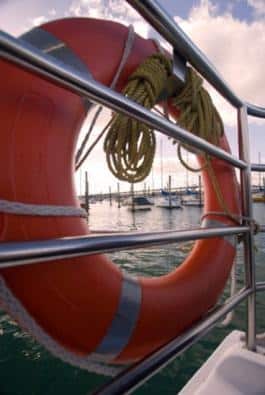
Maybe it’s just a leftover quirk from my old job, but when it comes to safety and survival equipment, I always like to see stuff work. With so much time around things gone wrong, I’ve developed a pragmatic “let’s try it out” approach to everything. One unlikely piece of gear that I’ve seen go very wrong (very often) is life rings. I know, right – how can a circular tube fail? They are the simplest piece of rescue equipment ever made. All they have to do is be round and float, but look around your own marina and you will see them reduced to uselessness all the time.
When you are on your boat next, do me a favor: try it out. Take your Type IV throwable PFD – life ring, horse collar, cushion – and throw it overboard. Time yourself. If it took you more than three to five seconds, things just went wrong. Look at the life ring in the photo above. To effectively use that particular life ring you would have to untie the small line securing it at the rail, and then unravel the polypropylene line before giving it a heave. I’m guessing, but I’m betting that would take longer than five seconds.
Throwable PFDs are about unexpected man-overboard situations where time is everything, especially in winter months. Most people who fall overboard don’t do it on flat calm days, so seas and weather may make the safe and speedy turn to retrieve your crew member more difficult than you imagined.
Set up your life rings (or whatever throwable device you chose) for speed. They should be able to be removed from the cradle or dropped from the rail almost immediately – without any more than a lift or a tug from a single securing line. If they are equipped with a retrieval line, secure them in such a way that they are ready to be used without any extra effort. I’ve seen retrieval lines secured using easily breakable thread in all variations of fancy loops or stars, but my favorite method for keeping these lines straight is the use of throw bags. These neat pouches keep the line from becoming tangled, protect the line from sun damage, and allow the line to pay out without any real intervention from the user.
Whatever your set-up is and whichever throwable PFD you chose to keep aboard, what matters most is that it works when you need it. Having them aboard isn’t enough. You have to spend time actually seeing the things work. They don’t throw themselves and set-up and practice can make the difference between a quick and easy toss, and a fifteen second (too long) struggle to use the simplest piece of safety gear on your boat.
* * * * *
The U.S. Coast Guard is asking all boat owners and operators to help reduce fatalities, injuries, property damage, and associated healthcare costs related to recreational boating accidents by taking personal responsibility for their own safety and the safety of their passengers. Essential steps include: wearing a life jacket at all times and requiring passengers to do the same; never boating under the influence (BUI); successfully completing a boating safety course; and getting a Vessel Safety Check (VSC) annually from local U.S. Coast Guard Auxiliary, United States Power Squadrons(r), or your state boating agency’s Vessel Examiners. The U.S. Coast Guard reminds all boaters to “Boat Responsibly!” For more tips on boating safety, visit www.uscgboating.org.








